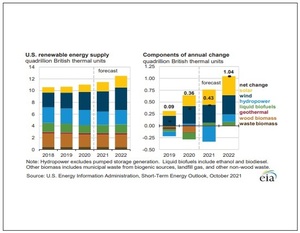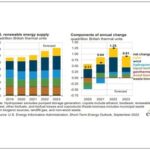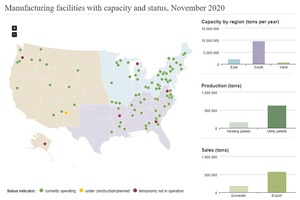EIA updates bioenergy forecasts for 2021, 2022
Energy Disrupter
ADVERTISEMENT
Renewables are expected to account for approximately 20 percent of U.S. electricity generation this year, increasing to 22 percent in 2022, according to the U.S. Energy Information Administration’s latest Short-Term Energy Outlook, released Oct. 13. Renewables accounted for approximately 20 percent of U.S. electricity generation last year.
The electric power sector is expected to generate 27 billion kilowatt hours (kWh) of electricity from biomass this year, including 15.7 billion kWh from waste biomass and 11.3 billion kWh from wood biomass. Biomass generation is expected to fall to 26.3 billion kWh in 2020, including 15.6 billion kWh from waste biomass and 10.7 billion kWh from wood biomass. The sector generated 27.5 billion kWh from biomass in 2020, including 16.1 billion kWh from waste biomass and 11.4 billion kWh from wood biomass.
Across other sectors, biomass generation was at 28.6 billion kWh in 2020, including 2.7 billion kWh from waste biomass and 25.8 billion kWh from wood biomass. Biomass generation is expected to fall to 28 billion kWh in 2021, including 2.7 billion kWh from waste biomass and 25.3 billion kWh from wood biomass, and be maintained at that level through next year.
The electric power sector is expected to consume 0.233 quadrillion Btus (quad) of waste biomass this year, falling to 0.231 quad in 2022, compared to 0.238 quad in 2020. The sector also consumed 0.185 quad of wood biomass last year. Consumption of wood biomass is expected to fall to 0.184 quad this year and 0.175 quad in 2022.
The industrial sector consumed 0.156 quad of waste biomass in 2020. Consumption is expected to increase to 0.157 quad this year before returning to 0.156 quad in 2022. The sector is also expected to consume 1.393 quad of wood biomass this year, up from 1.376 quad in 2020. The consumption of wood biomass is expected to increase to 1.411 quad next year.
The commercial sector consumed 0.036 quad of waste biomass last year. Consumption is expected to fall to 0.035 quad this year and be maintained at that level through next year. The sector is also expected to consume 0.082 quad of wood biomass in 2021 and 2022, down from 0.083 quad in 2020.
The residential sector is expected to consume 0.455 quad of wood biomass this year and next year, down from 0.458 quad in 2020.
Across all sectors, the consumption of waste biomass is expected to be at 0.425 quad this year, falling to 0.422 quad next year, compared to 0.43 quad in 2020. Wood biomass consumption was at 2.101 quad in 2020 and is expected to increase to 2.113 quad in 2021 and 2.123 quad in 2022.
The electric power sector is expected to have 6,184 megawatts (MW) of biomass power capacity in place at the end of 2021, including 3,822 MW of waste biomass capacity and 2,362 MW of wood biomass capacity. Biomass capacity is expected to increase to 6,190 MW by the end of 2022, including 3,829 MW of wood biomass capacity and 2,362 MW of waste biomass capacity. Biomass capacity was at 6,295 MW at the end of 2020, including 3,790 MW of waste biomass capacity and 2,505 MW of wood biomass capacity.
Across other sectors, biomass capacity is expected to be at 6,289 MW at the end of this year, including 778 MW of waste biomass capacity and 5,510 MW of wood biomass capacity. Biomass capacity is expected to fall to 6,281 MW by the end of 2021, including 778 MW of waste biomass capacity and 5,503 MW of wood biomass capacity. Biomass capacity was at 6,302 MW at the end of last year, including 777 MW of waste biomass capacity and 5,525 MW of wood biomass capacity.
















